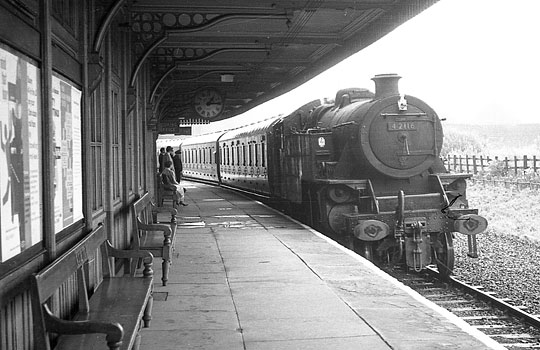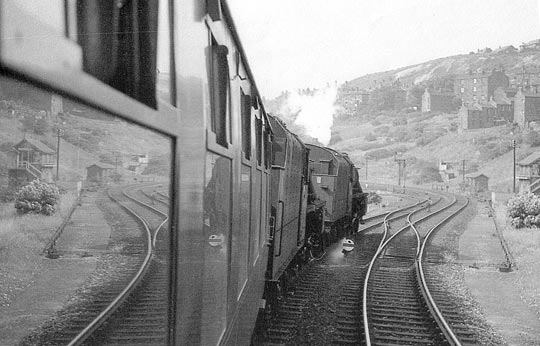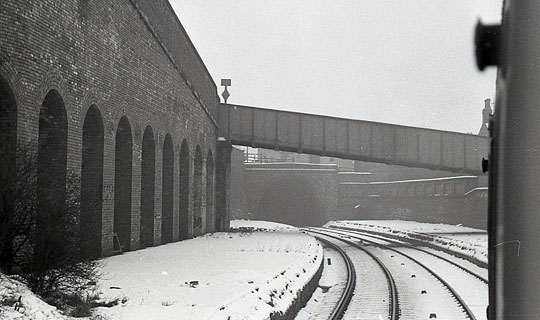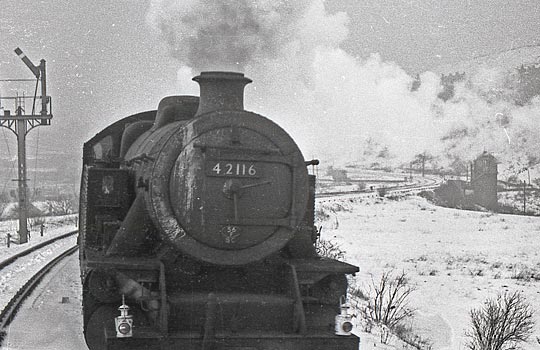Roger Hepworth recalls the journey from Ossett to Dewsbury on... Market day
Roger Hepworth recalls the journey from Ossett to Dewsbury on… Market day
One of the many small ways in which the 1950s railway used to touch us young children during our school holidays was the weekly Wednesday afternoon trip to Dewsbury market. After a morning of anticipation and a quickly-eaten dinner we would leave our houses and run along the road ahead of our mothers before scampering noisily down the lengthy covered approach ramp to the railway station. As we ran down our footsteps raised the echoes on the hollow-sounding boarded floor.
Once under the long wooden canopy which covered the island platform we would then enter the second of the several timber buildings, on the blue door of which was the oval orange-painted cast iron plate ‘Booking Hall’. When my turn came to stand at the ticket window, my back to the luggage rest with its blue-painted legs and shiny mahogany top, I would say my well-rehearsed line “One and a half Dewsbury return, please”, whilst straining to reach the upper hole in the thick glass ticket window. The booking clerk would whip two tickets from the huge rack at his side and deftly stab each into the green pillar-like dating press with a deep ‘thunk-bong’. He would then pass them out through the lower semi-circular cut-out in the glass. I duly slid across my ‘one and three ha’pence’ – 9d for the purple ‘British Railways’ adult ticket and 4½d for the LNER 3rd class pea-green child’s. These latter were issued right up to the closure of the station in 1964, when I purchased the official last one.
Shortly our respective mothers would arrive on the scene, having adopted a more leisurely pace, and we would all sit on the wooden platform benches, each with ‘Ossett’ in cast iron white painted letters set in an orange painted recess cut into the blue bench.

Photo: Roger Hepworth
After what, in our impatience, seemed an eternity the unique deep tone of the electric bell sounded its five-second ring. This was situated over the door to the wooden ‘Porters Room’ further along the platform and was presumably operated from Ossett East signal box. We would cross to the Up side of the island platform so as to get the first distant view of the train approaching around the left-hand curve. As it came over the level crossing we ran back to the Down side to see the engine enter the station under the road bridge. Generally it would be an N1 tank running, as always, chimney-first towards Bradford. The more usual formation of two non-corridor coaches would be generally strengthened on market days like this to three coaches, often with up to three four-wheeled vans also, coupled directly behind the engine.
As the train slowed down we would try to spot an empty compartment and run alongside it until the train stopped. The brass handle was turned, the door swung open and up we climbed. We sank into the red or brown upholstery of the long bench seats with their wonderful and indefinable aroma of old tobacco, damp overcoats and engine smoke.
The slamming of doors, a shout of “Right away!” from the guard along the platform, a blast from the steam whistle and the sure-footed engine puffed firmly away up the short rise before shutting off and gathering speed downhill past the up splitting somersault signals. After about half a mile we would look to the right at a mysterious single line curving away at Runtlings Junction. This was the route of the original 1870s line from Wakefield through Ossett to Batley, via Chickenley Heath, which avoided Dewsbury and made the famous not-quite-triangular junction with the rest of the system at Batley. The line was still used at this time as an outlet for coal from Shaw Cross Colliery. On we clattered down the later line towards Earlsheaton where we always hoped that new passengers would not enter ‘our’ compartment. During the short station stop metallic scraping noises from the engine told of the fireman’s efforts in building up the fire to cope with the steep gradient which the train would face on leaving Dewsbury in a few minutes’ time.

Photo: Roger Hepworth
As the resultant black smoke and safety valve steam beat past our offside window the porter would walk along the platform side of the train repeatedly shouting “Ellzeetun”. After the closure of this station in around 1955 it seemed strange yet exciting to run through non-stop with just a crow on the whistle for the approaching tunnel. It was then just a short distance to go, with Dewsbury signal box on our right and the extensive goods yard on our left. In the distance could be seen the two disused bowstring girder bridges carrying the trackbed of the erstwhile GN Headfield branch over the River Calder to join the L&Y main line at Thornhill. On the closure of the Ossett line the unlikely step had to be taken of relaying this branch which had been closed in the 1930s. It was the only access to the still thriving Dewsbury goods yard until it in turn closed some twenty years later. The bridge girders are still there, disused for the second time but now hosting a footpath.
Our train now negotiated the short tunnel under Wakefield Road before emerging and squealing around the right-hand curve into Dewsbury Central Station. This was constructed on two levels. The upper one consisted of the island platform with its substantial stone buildings and full length saw-tooth glass roof. There was a luggage lift at the Bradford end with a black-painted panel on the stonework down at street level bearing the message in white letters ‘Ring Three Times for Porter’. From the centre of the platform a wide stone stairway with highly polished brass handrails at each side and a short landing halfway down led to the lower level. Here an extensive stone-flagged circulating area, bounded by booking and parcels offices, was roofed by the girders and jack-arching which carried the tracks and platform above.
The platform level commanded a good view over much of Dewsbury market and town centre but this was now masked by the train from which we were now alighting. Porters set about unloading produce from the four-wheel vans, to say nothing of prams and parcels from the passenger guards van. All this was accomplished so smartly, however, that we only just had time to hand in our tickets, go down the steps and be out in the street so as to look back and up at our train as it departed – now high above us – up the steep gradients to Batley and eventually Bradford.

Photo: Roger Hepworth
Each family would then go its separate way into the bustle of shopping at the market, in our case followed by ‘tea and cakes’ for Mother and an ice cream for me at the Playhouse Café. This comprised an upstairs room in the Egyptian-style cinema of that name which survived until the late 1990s, only to be demolished and replaced by a Wilkinson’s hardware store. All this was served by a waitress in classic black uniform with white apron and receipt pad on a string at her waist as we sat surrounded by the latest veneered wood radiograms and new-fangled upright TV sets with doors supplied by James W Thornes, for many years the local electrical and record retailer who presumably paid to have his latest stock on public display in the café.
By now it would often be dark as we emerged from the cinema, turned right and walked the twenty yards or so back to the station forecourt – all too often wet and reflecting the gaslights from the cobbles. Just before closure electric lighting was installed at street level so as to facilitate the sorting of the many parcels. I would quickly survey the excursion handbills – here displayed in an extensive wooden three-decker rack, unlike at Ossett where they were hung from nails on pieces of string. Also unlike at Ossett, where destinations were restricted mainly to East Coast resorts, here were the delights of Southport, Blackpool or Belle Vue, accessible from the other Dewsbury station at Wellington Road. Then it was up the gas-lit stairway with its white glazed-brick walls and onto the platform.
Each side of the island was lit by a row of gas lamps hanging down from the canopy. On the Ossett-bound side at this time of day would be several four-wheel barrows stacked high with grey fibre cases, the gaslight glinting off their black metal corners and strapping. These contained garments returning from Jas Smith’s dry-cleaners in Dewsbury to customers in Ossett and Wakefield. There was a 6d in the slot vending machine at the side which dispensed Sunpat chocolate peanuts or raisins, depending on which of the two metal drawers one pulled out. These would generally be consumed on the Bradford-bound platform while we took advantage of the bird’s eye view over the town. On the right there was the large works of the rival dry cleaners, Silver’s, while ahead was Dewsbury market and beyond that the tower clock of the several storeys high Co-op building which also housed a cinema. This always showed a slightly different time from the other prominent tower clock of the Town Hall.

Photo: Roger Hepworth
Then it was back to the other platform so as to see Dewsbury Junction Up Distant signal – situated just by the tunnel mouth – clear for our train. This signal later changed from somersault to upper quadrant and just before closure to a twin aspect colour light. Soon the sounds of an engine could be heard coasting down the hill from Batley and we would glimpse the single high-mounted class B headlamp in the distance, flickering with the vibration of the engine. The bunker of the N1 tank – or tender if it were a J6, J39 or B1 – loomed into view with its two non-corridor coaches.
With us safely on board there would be a ‘pop’ of the whistle and the engine would puff gently into the short tunnel which could be identified from the road above by the clearly-visible red-brick airshaft with heavy stone toppings and dome-shaped iron grid. Down on the right as we left the tunnel gleamed the Railway Street Goods Yard gas lamps. Still puffing gently the engine squealed around the reverse curves atop the long panelled brick retaining wall and over the goods yard junction with the lighted windows of the signal box on our left. As a little boy I always felt that the view from the left hand side of the train here was rather sinister with its high gloomy cutting walls and the derelict remains of a large textile mill. I much preferred the more benign atmosphere of the other side with its view over the broad Calder valley, often cheered by an orange sunset as the golden steam of our now hardworking engine beat back across the windows.

Photo: Roger Hepworth
Through the short Earlsheaton Tunnel and in later years a non-stop run through the closed station with its typical GN brick and timber signal box on the down side controlling the gated single line which led to the little local colliery. We chattered on past the large brick goods shed on the left with its sidings – the occasional white painted chair indicating the fouling spots for the points. The engine’s brisk exhaust sharpened further now for the steep two-mile gradient up to Ossett. Chickenley cricket field was passed on our left while the Calder valley continued on our right. Then the relative silence as steam was shut off for the short down gradient into Ossett. The tungsten lights flicked brighter as they cut from dynamo to battery power, then it was down with the window and out onto the platform. Tickets were pressed into the outstretched palm of the porter on duty who then walked smartly along the platform to close any doors remaining open.
The walk towards the station exit ramp took us past the warm engine whose driver would smile down at us in the orange glow from the fire box. On at least one occasion the engine was a massive clean B1 with red lined boiler bands. Running tender-first it looked most incongruous, with its large outside cylinders, abutting onto the coaches. As we climbed towards the road the porter’s voice would shout “Right away!” to the driver who would whistle and yank open the regulator to produce electric-style acceleration down the hill to Wakefield. The lighted coach windows sped past leaving a few leaves whirling along in their wake and a view of the end windows of the guards van retreating into the darkness. The top of the ramp was reached, illuminated by its tungsten bulb, and there would be shouts from our mothers of “Don’t go into the road”. As if we would – how silly mothers can be! Once home a good scrub was enforced ‘to wash off the railway dirt’ and then we would feast on the spoils from Dewsbury market, including luscious roast pork with stuffing, and dripping from a local butcher’s stall.
In a few short years the line was to be largely dieselised and then closed completely. All that now remain are the fond memories and the delicious pork and dripping which can still be obtained from the very same stall fifty years on.





